Ancient lye kettles were primarily made from thick-walled cast iron (about one inch thick) due to their ability to withstand caustic solutions and intense heat. When iron wasn't available, civilizations used glazed clay vessels or lined wooden barrels as alternatives. Specialized clay pots were crafted specifically for leaching lye from wood ash, often strengthened with tempering materials like crushed potsherds and plant fibers. The material choice depended on local resources, production needs, and safety concerns throughout history.
The Origins of Lye Kettles in Ancient Civilizations
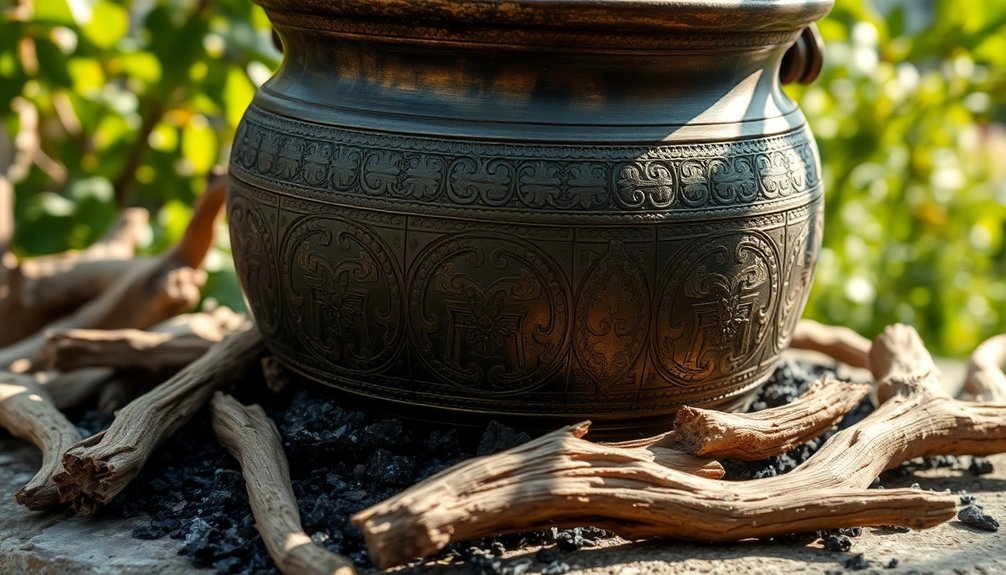
While the practice of using kettles for various purposes dates back thousands of years, the specific use of lye kettles has a complex history that intertwines with early soap-making traditions.
You'll find that ancient civilizations like Mesopotamia used bronze and iron kettles as early as 3500 B.C., primarily for boiling water for medicinal purposes. Colonial settlers would later use large kettles for combining fats and lye to produce soap through a lengthy boiling process.
Romans contributed to this evolution with their bronze pots designed for boiling water.
Though direct evidence linking ancient kettles specifically to lye is limited, these vessels were likely used in soap-making processes.
The Babylonians created soap-like substances by boiling fats with wood ashes around 2800 B.C., while Egyptians made early forms of lye by mixing ashes and water to soften skins.
This practical knowledge gradually evolved into more structured soap-making traditions.
Wood Ash Leaching Vessels: Materials and Techniques
You'll find that ancient leaching vessels were primarily made of clay due to its excellent resistance to the caustic alkalines produced during the wood ash leaching process.
When selecting materials for these vessels, our ancestors carefully chose hardwoods like oak and maple, which produced ash with higher potassium carbonate content essential for effective lye production.
The specific clay composition and firing techniques varied by region, but most cultures developed thick-walled, sometimes glazed pottery that could withstand repeated exposure to the highly corrosive solutions.
Clay Leaching Pots
Ancient artisans crafted specialized clay vessels designed specifically for the vital process of leaching lye from wood ash. These pots were typically made from earthenware clay, prized for its high porosity that facilitated the leaching process.
You'll find that potters used various tempering materials like crushed potsherds, plant fibers, or quartz to strengthen their vessels. They'd prepare the clay by pounding it into powder, mixing it with water and temper, then shape it using techniques like coiling or pinching.
After forming, the pots were dried to a leather-hard state before firing at relatively low temperatures in simple kilns or pits.
These specialized vessels served significant roles in historical societies, enabling soap production and textile processing through the alkaline lye they helped extract from wood ash.
Hardwood Selection Process
When selecting wood for ash leaching vessels, the choice of hardwood species greatly impacted the final product's quality and effectiveness. You'd want to take into account the ash composition, as different hardwoods yielded varying potassium content essential for lye production.
| Hardwood Type | Leaching Properties |
|---|---|
| Oak | High potassium, slow burning |
| Maple | Medium potassium, clean ash |
| Hickory | Excellent mineral content |
| Ash | Low foreign material, efficient |
| Beech | Consistent yield, minimal impurities |
The selection process required careful attention to potential contaminants. Avoiding wood with nails, paint, or other foreign materials prevented unwanted chemical reactions. The environmental conditions where the trees grew also influenced mineral composition, making locally sourced hardwoods uniquely suited to regional leaching practices.
Iron Kettles: The Evolution of Durability for Lye Processing
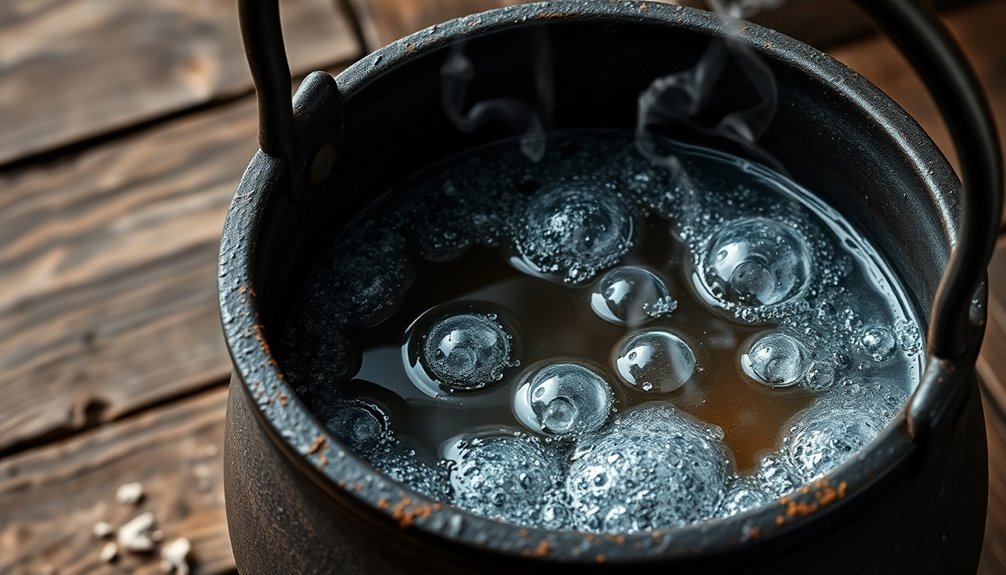
Iron kettles revolutionized lye processing in early America, transforming what was once a rudimentary household task into a lucrative industrial operation.
You'd find these kettles cast exceptionally thick to withstand the caustic solutions and intense heat required during the boiling process.
When you needed to produce lye, you'd leach wood ashes with water, then transfer the resulting liquid to these durable iron vessels for boiling over charcoal fires. This process yielded potash, a valuable commodity used in soap making, glass production, textile dyeing, and agriculture.
As demand increased, improvements in iron casting techniques allowed for larger, more resilient kettles.
Despite the eventual emergence of more efficient methods, these kettles' remarkable heat resistance and durability made them essential tools in early industrial development.
Clay Pots and Earthenware in Traditional Soap Making
Clay and earthenware vessels have survived centuries of soap making due to their remarkable lye-resistant properties.
You'll find that traditional potters often treated these vessels with wood ash solutions before use, creating a natural barrier against caustic lye solutions.
This ash-based preparation method not only extended the pot's lifespan but also prevented contamination of the soap mixture with unwanted minerals from the clay.
Pottery's Lye-Resistant Properties
Throughout history, pottery vessels have proven remarkably effective for working with caustic substances like lye. Clay's inherent resistance to chemical reactions made it the ideal material for soap makers handling this dangerous alkaline solution.
When you're working with lye, you need containers that won't corrode or contaminate your mixture. Earthenware excelled in this regard, as it didn't react with lye like metal vessels would. Unlike modern containers, traditional potters specifically avoided aluminum or tin which can react dangerously with lye solutions.
These clay pots also provided excellent thermal resistance, maintaining steady temperatures during the critical saponification process.
You'll find that ancient potters often customized these vessels specifically for soap making, balancing practical needs with durability.
The porous yet stable nature of fired clay created an ideal environment for safely mixing oils and lye while controlling moisture absorption—a perfect marriage of safety and functionality.
Ash-Based Preparation Methods
When investigating traditional soap making, you'll discover that ash-based methods formed the foundation of lye production throughout history. Hardwoods like ash, hickory, and beech were preferred for their higher potassium content—essential for effective lye.
The process began by collecting cooled ashes in metal containers, protecting them from rain to prevent leaching. These ashes were then layered with straw and small sticks in a barrel or ash hopper, allowing water (preferably rainwater) to seep through and extract alkaline compounds. The concentration of the potash solution could be increased by reusing water or through boiling to achieve suitable strength for soap making.
The resulting brownish liquid would drip into clay pots or vessels designed to withstand the solution's corrosive nature.
This lye solution was then combined with rendered fats over heat, creating a soft, jelly-like soap that was typically stored in wooden barrels.
Stone Containers: Resilience Against Caustic Solutions
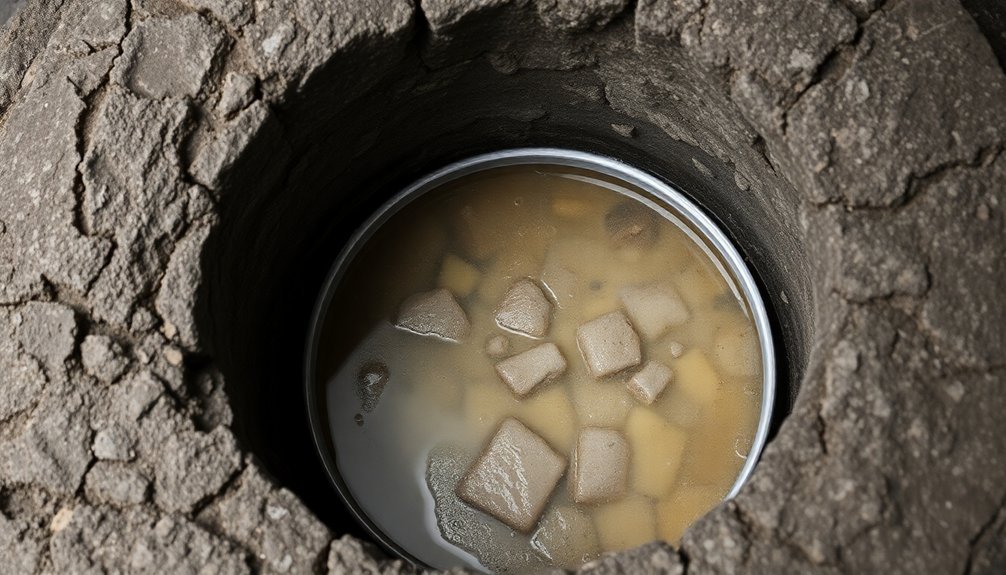
Ancient civilizations faced significant challenges when storing caustic solutions like lye in stone containers. While you might assume stone would resist corrosion, the evidence suggests otherwise. Many stone types gradually degrade when exposed to concentrated alkaline substances like sodium hydroxide, experiencing surface etching and structural weakening over time.
You'd find that granite offers better chemical resilience than softer stones, but even it isn't immune to lye's caustic properties. The practicality of stone containers was further limited by their substantial weight and the difficulty in thoroughly cleaning them after use. The increased weight was further compounded by the fact that lye solution weighs 1.5 times more than water.
Despite these drawbacks, stone containers might've been used when alternatives weren't available, though they'd require regular maintenance. Unfortunately, historical records documenting stone's specific use for lye storage remain scarce.
Historical Evidence of Wooden Buckets for Lye Collection
You'll find that colonists collected potash lye through a process where water was poured over wood ashes in specially constructed wooden buckets called drip-tubs.
Though wood wasn't ideal for long-term storage of corrosive lye, these containers remained popular due to their availability and ease of manufacturing compared to stone or metal alternatives.
The typical colonial lye drip-tub featured small holes at the bottom, layered filtering materials such as straw or sand, and often sat elevated to allow for collection of the caustic solution in a separate container below.
Wood Ash Leaching Process
Throughout history, wooden buckets played an essential role in the wood ash leaching process for lye collection. You'd find these containers positioned beneath ash-filled barrels or troughs to catch the resulting lye solution as water filtered through the ashes.
The leaching process followed these vital steps:
- Hardwoods like hickory were burned to produce ash containing potassium salts.
- The collected ash was placed in a wooden container with small drainage holes.
- Water was poured over the ash, dissolving soluble potassium compounds.
- The resulting lye solution dripped into collection buckets below.
The efficiency of this process depended on factors like wood type, burn temperature, and leaching setup.
You could test the lye's strength through traditional methods such as observing if it dissolved feathers or floated an egg.
Bucket Material Durability
Historical evidence confirms wooden buckets served as the primary vessels for lye collection, despite the caustic nature of this substance. During the colonial era, these handcrafted containers became essential for daily activities, particularly in laundry preparation.
You'll find that wooden buckets weren't randomly constructed; they required skilled craftsmanship using specific wood types chosen for their resistance to rot. Artisans employed barrel-making techniques, using staves held together by metal hoops and sealed with materials like wood tar to prevent leakage.
Though metal alternatives existed, they remained rare due to high costs and limited accessibility. While continuous exposure to lye created durability challenges, regular maintenance extended the buckets' lifespan.
Written accounts from the period substantiate their widespread use, despite limited archaeological evidence remaining due to wood's perishable nature.
Colonial Lye Drip-Tubs
Colonial American households depended on specialized wooden containers called lye drip-tubs, which served as essential equipment for producing homemade soap.
You'd typically find three main designs: standard barrels with drilled bottoms, wedge-shaped hoppers, or square conical hoppers—all designed to leach lye water from hardwood ashes.
To operate your drip-tub effectively, you'd:
- Line the bottom with straw to prevent clogging and filter impurities
- Fill the container with high-quality hardwood ashes (oak, hickory, maple)
- Pour water slowly over ash, collecting the amber lye solution below
- Test the lye's strength before combining with animal fats for soap-making
These leaching devices were positioned over stone slabs with grooves that directed the potent alkaline solution into collection vessels, allowing frontier families to maintain self-sufficiency through seasonal soap production. For many colonists, this activity occurred in the fall or winter when freshly butchered animal fats became available.
Ceramic Vessels: Glazing Techniques for Lye Resistance
When creating ceramic kettles for lye applications, artisans developed sophisticated glazing techniques to protect vessels from caustic degradation. They relied heavily on alumina (Al₂O₃) and silica (SiO₂) to create durable, chemical-resistant surfaces.
You'll find that proper bisque firing at higher temperatures was vital before applying glazes, as it removed organics and prepared the clay body.
Artisans often layered glazes, using feldspar as a flux to lower melting points and guarantee proper vitrification. Calcium carbonate (whiting) enhanced melting and durability.
The most effective lye-resistant vessels incorporated high boron content with kaolin additions to boost alumina levels.
Skilled potters controlled thermal expansion carefully to prevent cracking and used wax resist techniques to create patterns while maintaining chemical resistance in critical areas.
Material Innovations Across Medieval Soap Making Guilds
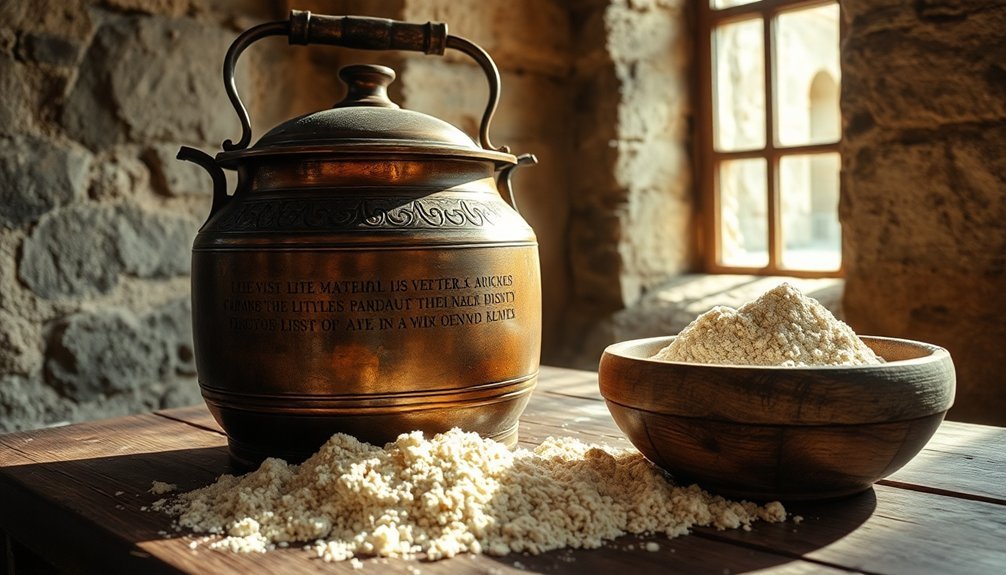
Medieval soap-making guilds revolutionized kettle materials through specialized adaptations to handle corrosive lye processes.
You'll find these artisans developed sophisticated techniques for producing and storing their caustic solutions, which typically reached pH levels around 11—weaker than modern formulations but still demanding specialized containment.
- Potash extraction vessels evolved to withstand repeated leaching of wood ash with rainwater, enabling guilds to remove unwanted minerals through evaporation techniques. In the 7th Century, Italian soap makers organized into craft guilds that jealously guarded their techniques for creating durable extraction vessels.
- Calcining containers became essential when artisans discovered adding lime could fortify lye solutions for more effective saponification.
- Commercial soap vats featured innovative drain systems that captured valuable "second lye" containing glycerin—a profitable byproduct sold to other craftsmen.
- Specialized heating kettles allowed continuous adjustment of the soap mixture during cooking, compensating for the lack of precise measurements in medieval recipes.
Regional Variations in Lye Kettle Construction
Regional variations in lye kettle construction reflected both material availability and cultural practices across different parts of the world.
European settlements favored stone leaching beds, particularly where granite was abundant, while American colonists adapted by using available wood for hoppers and native stone for lye stones.
You'd find iron kettles with thick walls widely used across regions for boiling and concentrating lye.
In some areas, you might notice carved grooves in stones showing distinct craftsmanship styles that facilitated collection.
Asian and African traditions likely employed similar principles but with unique regional adaptations, though historical documentation remains less detailed than European methods.
Operational approaches varied too—some communities preferred continuous dripping processes, while others allowed extended soaking periods before collection, all while protecting their setups from rainfall. The resulting product was a combination of hardwood ashes and water, making lye production accessible across various cultures.
Practical Considerations for Lye-Resistant Materials Through History
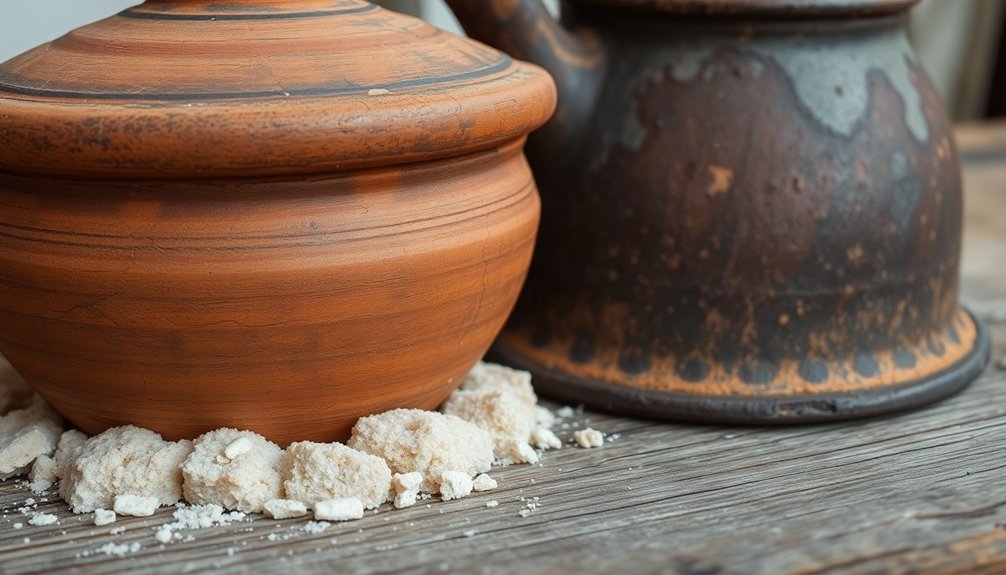
Throughout history, practical considerations for lye-resistant materials centered on durability and corrosion resistance in harsh chemical environments.
You'd find thick-walled cast iron kettles approximately one inch thick, specifically designed to withstand the caustic nature of lye solutions. When iron wasn't available, people improvised with glazed clay vessels or lined wooden barrels.
The choice of materials wasn't just about function but also economic feasibility:
- Resource availability – Communities used locally accessible materials, adapting techniques to what they had.
- Production efficiency – Larger kettles meant greater output but required more initial investment.
- Safety concerns – Proper materials prevented dangerous spills and burns.
- Trade value – Quality potash production demanded suitable containers, as the final product was a valuable trade commodity.
Historically, these vessels needed to withstand repeated cycles of mixing wood ash with hot rainwater to enhance the extraction of potash for strong lye solutions.
The Science Behind Material Selection for Caustic Alkali Solutions
The science of material selection for caustic alkali solutions extends far beyond simple durability concerns. When dealing with lye's highly corrosive nature, you'll find that material properties at the molecular level determine survival rates.
At high pH levels, metals like iron undergo accelerated corrosion, while nickel forms a protective oxide layer.
Iron surrenders to caustic attack while nickel shields itself behind its protective oxide barrier.
Temperature dramatically impacts material performance—what works at room temperature might fail catastrophically when heated. This explains why ancient civilizations favored ceramics and specially-treated clay vessels for alkali production. Their naturally non-reactive properties prevented the caustic embrittlement that plagued metal containers.
Understanding concentration effects is equally critical. You'll need different materials for handling dilute solutions versus concentrated lye, as corrosion rates increase exponentially with concentration, particularly above 50% strength.
Frequently Asked Questions
How Did Ancient Civilizations Measure Lye Concentration Without Modern Tools?
You'd measure lye concentration using the egg float test, where an egg floating with its tip visible indicated proper strength. You could also taste for "zappiness" or observe texture when making soap.
Did Corrosion Patterns in Ancient Kettles Leave Identifiable Archaeological Markers?
Yes, you'll find distinctive archaeological markers in ancient kettles' corrosion patterns. These include diagnostic color changes, mineral deposits like malachite, preferential grain boundary corrosion, and layered patinas that reveal both composition and manufacturing techniques.
How Long Did Typical Lye Kettles Last Before Requiring Replacement?
You'd typically replace your lye kettles based on material. Clay vessels lasted years with proper care, wooden barrels needed replacement every few seasons, while iron containers corroded faster due to lye's caustic nature.
Were Special Tools Developed Specifically for Handling Lye Kettles?
You'd rarely find specialized tools made just for lye kettles. Instead, people adapted common items like wooden paddles, long-handled spoons, and tongs to safely maneuver these vessels while protecting themselves from the caustic liquid.
Did Lye Kettle Designs Influence Other Household Container Developments?
Yes, you'll find lye kettle designs influenced many household containers. Their durable materials, safety features, and drainage systems inspired improvements in brewing vessels, storage containers, and cooking pots during the 18th and 19th centuries.
In Summary
Throughout history, you've seen how diverse materials served as vessels for caustic lye solutions. From durable cast iron to specialized ceramics, stone basins, and even wooden ash hoppers, each material offered unique benefits. You'll notice these choices weren't random but reflected available resources and technical knowledge. As you explore historical soap making techniques, you'll appreciate how these material innovations enabled essential household production despite lye's corrosive nature.

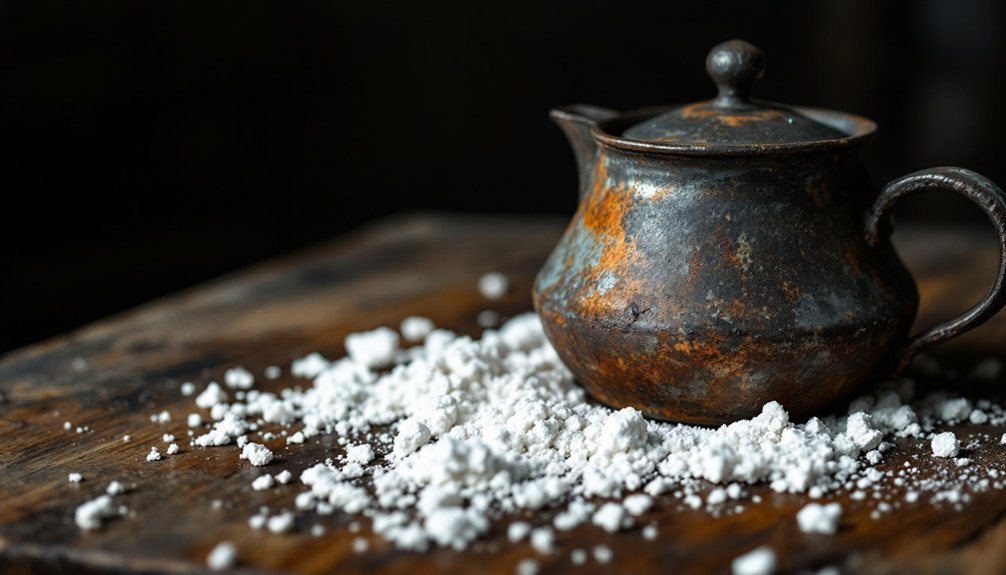



Leave a Reply